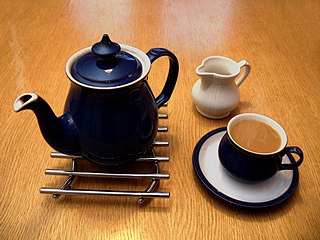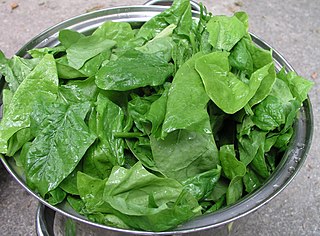
Aojiru (青汁) is a Japanese vegetable drink most commonly made from kale or young barley grass. [1] The drink is also known as green drink or green juice in English, a direct translation of the Japanese meaning.

Aojiru (青汁) is a Japanese vegetable drink most commonly made from kale or young barley grass. [1] The drink is also known as green drink or green juice in English, a direct translation of the Japanese meaning.
Aojiru was developed in October 1943 by Dr. Niro Endo (遠藤仁郎, Endō Nirō), an army doctor who experimented with juices extracted from the discarded leaves of various vegetables in an attempt to supplement his family's meager wartime diet. He credited the cure of his son from pneumonia and of his wife from nephritis to aojiru, and in 1949 concluded that kale was the best ingredient for his juice. [2]
Aojiru was popularized in 1983 by Q'SAI (キューサイ), who started marketing 100% kale aojiru in powdered form as a dietary supplement, and sales boomed after 2000 when cosmetics giant FANCL started mass retailing of the juice. [2] Today, many Japanese companies manufacture aojiru, usually using kale, young barley or komatsuna leaves as the base of the drink, and the size of the aojiru market was well over $500 million in 2005. [3]
In 1990, actor and former baseball player Nobuo Yana was hired by Q'SAI as a testimonial for the drink, and his own impressions of it resulted in the commercial's famous tagline "Horrible! I'll have another one." (Mazui! Mou ippai (まずい!もう一杯)). [4]
Aojiru is a rich source of certain vitamins and minerals, and care should therefore be taken when undergoing certain treatments or if on certain medication.[ citation needed ] The high levels of potassium, phosphorus, and vitamin A are said to worsen the health of patients on dialysis,[ citation needed ] while the high levels of vitamin K could decrease the effectiveness of medication taken for circulatory problems.[ citation needed ]
The taste of aojiru is famously unpleasant, so much so that drinking a glass of the liquid is a common punishment on Japanese TV game shows. [5] However, new formulations of aojiru have attempted to minimize the bitter taste of the original.

A drink or beverage is a liquid intended for human consumption. In addition to their basic function of satisfying thirst, drinks play important roles in human culture. Common types of drinks include plain drinking water, milk, juice, smoothies and soft drinks. Traditionally warm beverages include coffee, tea, and hot chocolate. Caffeinated drinks that contain the stimulant caffeine have a long history.
A macrobiotic diet is a fad diet based on ideas about types of food drawn from Zen Buddhism. The diet tries to balance the supposed yin and yang elements of food and cookware. Major principles of macrobiotic diets are to reduce animal products, eat locally grown foods that are in season, and consume meals in moderation.

Scurvy is a disease resulting from a lack of vitamin C. Early symptoms of deficiency include weakness, fatigue, and sore arms and legs. Without treatment, decreased red blood cells, gum disease, changes to hair, and bleeding from the skin may occur. As scurvy worsens, there can be poor wound healing, personality changes, and finally death from infection or bleeding.

Vitamins are organic molecules that are essential to an organism in small quantities for proper metabolic function. Essential nutrients cannot be synthesized in the organism in sufficient quantities for survival, and therefore must be obtained through the diet. For example, Vitamin C can be synthesized by some species but not by others; it is not considered a vitamin in the first instance but is in the second. Most vitamins are not single molecules, but groups of related molecules called vitamers. For example, there are eight vitamers of vitamin E: four tocopherols and four tocotrienols.

Fuze Beverage, commercially referred to as simply Fuze, is a manufacturer of teas and non-carbonated fruit drinks enriched with vitamins. Currently the brand consists of five vitamin-infused lines: Slenderize, Refresh, Tea, Defensify, and Vitalize. The use of vitamins, amino acids, and herbs, and alternative sweeteners such as crystalline fructose places Fuze products in what is known in the industry as the new age beverage category.

Fenugreek is an annual plant in the family Fabaceae, with leaves consisting of three small obovate to oblong leaflets. It is cultivated worldwide as a semiarid crop. Its seeds and leaves are common ingredients in dishes from the Indian subcontinent, and have been used as a culinary ingredient since ancient times. Its use as a food ingredient in small quantities is safe.

Shōchū is a Japanese distilled beverage. It is typically distilled from rice, barley, sweet potatoes, buckwheat, or brown sugar, though it is sometimes produced from other ingredients such as chestnut, sesame seeds, potatoes, or even carrots.

Vegetable juice is a juice drink made primarily of blended vegetables and also available in the form of powders. Vegetable juice is often mixed with fruits such as apples or grapes to improve flavor. It is often touted as a low-sugar alternative to fruit juice, although some commercial brands of vegetable juices use fruit juices as sweeteners, and may contain large amounts of sodium.

Goji, goji berry, or wolfberry is the sweet fruit of either Lycium barbarum or Lycium chinense, two closely related species of boxthorn in the nightshade family, Solanaceae. L. barbarum and L. chinense fruits are similar but can be distinguished by differences in taste and sugar content.

Leaf vegetables, also called leafy greens, pot herbs, vegetable greens, or simply greens, are plant leaves eaten as a vegetable, sometimes accompanied by tender petioles and shoots. Leaf vegetables eaten raw in a salad can be called salad greens.

Wheatgrass is the freshly sprouted first leaves of the common wheat plant, used as a food, drink, or dietary supplement. Wheatgrass is served freeze dried or fresh, and so it differs from wheat malt, which is convectively dried. Wheatgrass is allowed to grow longer and taller than wheat malt.

Juice Plus is a branded line of dietary supplements. It is produced by Natural Alternatives International of San Marcos, California, for National Safety Associates. Introduced in 1993, the supplements are distributed by NSA via multi-level marketing. Juice Plus supplements contain fruit and vegetable juice extracts with added vitamins and nutrients.

Naked Juice is an American brand that produces juices and smoothies. The company is based in Monrovia, California and is owned by PAI Partners. The first Naked Juice drink was produced in 1983 and sold in California under the name "Naked Juice", referring to the composition of no artificial flavors, added sugar, or preservatives. Distribution has since expanded, and Naked Juice products are distributed in the United States, as well as in Canada, the United Kingdom, the Netherlands and France, among others.

Monster Beverage Corporation is an American beverage company that manufactures energy drinks including Monster Energy, Relentless and Burn. The company was originally founded as Hansen's in 1935 in Southern California, originally selling juice products. The company renamed itself as Monster Beverage in 2012, and then sold their Hansen's juices and sodas and their other non-energy drink brands to the Coca-Cola Company in 2015.
Food chemistry is the study of chemical processes and interactions of all biological and non-biological components of foods. The biological substances include such items as meat, poultry, lettuce, beer, milk as examples. It is similar to biochemistry in its main components such as carbohydrates, lipids, and protein, but it also includes areas such as water, vitamins, minerals, enzymes, food additives, flavors, and colors. This discipline also encompasses how products change under certain food processing techniques and ways either to enhance or to prevent them from happening. An example of enhancing a process would be to encourage fermentation of dairy products with microorganisms that convert lactose to lactic acid; an example of preventing a process would be stopping the browning on the surface of freshly cut apples using lemon juice or other acidulated water.

A smoothie is a beverage made by puréeing ingredients in a blender. A smoothie commonly has a liquid base, such as fruit juice or milk, yogurt or ice cream. Other ingredients may be added, including fruits, vegetables, non-dairy milk, crushed ice, whey powder or nutritional supplements.
Jūrokucha (十六茶) is a blended tea drink produced and distributed by Asahi Soft Drinks in Japan. The drink was originally created and sold by Chanson Cosmetics as a dry blended green tea. Beginning in March 1993, Chanson and Asahi Soft Drinks released Jūrokucha as a joint venture premade beverage. In February 2007, the packaging and flavor was updated.

Roselle juice, known as bissap, wonjo, foléré, dabileni, tsobo, zobo, siiloo or sobolo in parts of Africa, sorrel in the Caribbean, and agua de Jamaica in Mexico, is a drink made out of the flowers of the roselle plant, a species of Hibiscus. Although generally the "juice" is sweetened and chilled, it is technically an infusion and when served hot can also be referred to as hibiscus tea.

Hemp juice is a beverage derived from industrial hemp, made from the result of pressing the Cannabis sativa plant. The juice is obtained through a large-scale industrial cold-pressing procedure using the upper parts of the hemp plant as well as the leaves. This procedure distinguishes hemp juice from other hemp products such as hemp oil, hemp sprouts or hemp milk, which are obtained through the seeds of the hemp plant.
Anthony William Coviello, known professionally as Anthony William or the Medical Medium, is a self-proclaimed medium who offers health advice based on alleged communication with a spirit. He authors books and offers advice online on forums such as Gwyneth Paltrow's Goop column and his own website. William believes that the Epstein-Barr virus is responsible for multiple ailments, including cancer. He claims to be the originator of the lemon juice in water morning detox as well as celery juicing, which he claims can offer many health benefits. Critics allege that he is practicing medicine without a license and that he has, at times, improperly solicited positive Amazon reviews for his books.